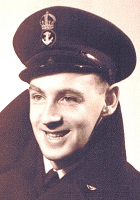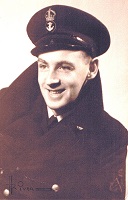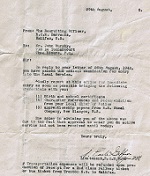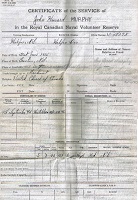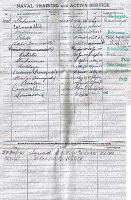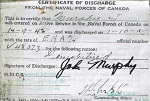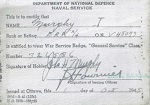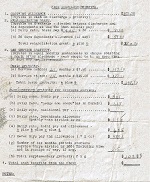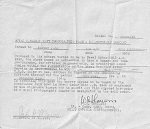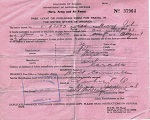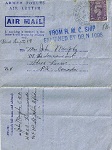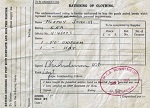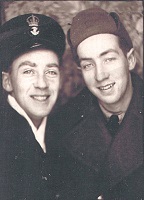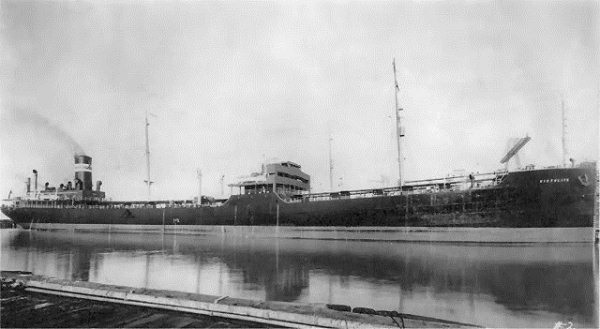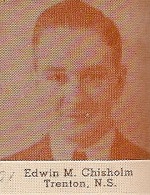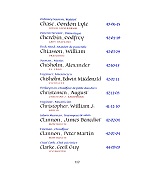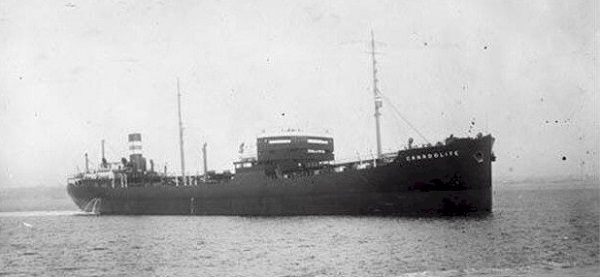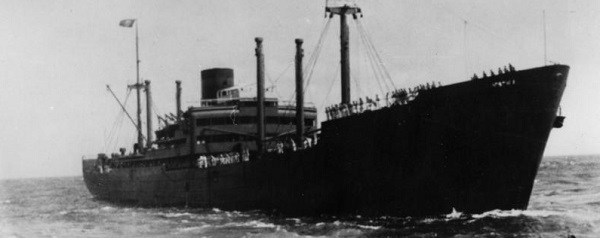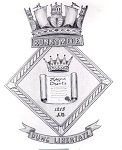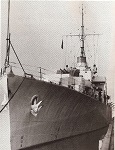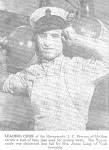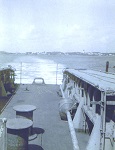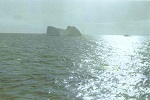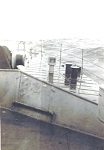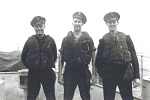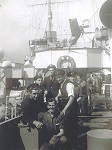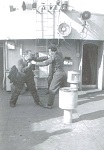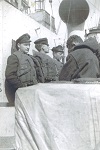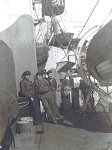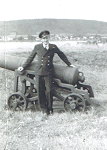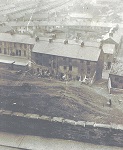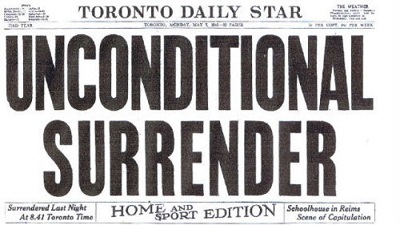|
In memory of those who have Crossed the Bar
The write-up below on John Murphy, his cousin Edward Chisholm (SS Victolite) and his friend Bink Tutty (SS Candolite) were submitted by Thomas Murphy, John's son.
In the early stages of the Second World War John had a chance to sail to Europe in 1941 working onboard a tanker. He turned it down, but referred a friend Bink Tutty to the job. The ship, an Imperial Oil tanker, the Candolite, was captured by the German raider Kormoran in March 1941. Bink spent until 145 in various German P.O.W. camps. A cousin of John's, Edwin Chisholm, went also in one of these ships, the Victolite, and his ship was sunk on 10 Feb 1942 by U-564. Edwin was the son of John's uncle Alex Chisholm. Edwin was lost in this sinking.
Historical note on the Imperial Oil's "Lite" tankers: On 04 Feb, U-109 torpedoed and sank SS Montrolite, an Imperial Oil tanker en route from Venezuela to Halifax. Only twenty of Montrolite's crew of forty-eight were rescued. On 18 Jan 1942, U-564, a VIIc class U-boat, left La Pallice, France under the command of Reinhard Suhren for operations of the US East Coast. On 10 Feb, northwest of Bermuda, U-564 torpedoed and shelled SS Victolite, bound for Las Peidras, Venezuela. Note of Victolite's crew of 45 and two gunners survived although a SOS was sent and received by the US Navy. On 05 May, SS Calgarolite, sailing for Cartagena, was torpedoed by U-125 south of Cuba. There were no casualties but three of Canada's fur largest tankers had been destroyed within a space of a few months.
John volunteered for and was accepted in the RCNVR in 1942 as an Engine Room Artificer 4th Class, Petty Officer, V48703. John began his service at the training depot HMCS CORNWALLIS in Halifax. He was there from 15 Sep 1942 until 16 Nov 1942 to complete new entry training. He was then drafted to HMCS STADACONA in Halifax for further training until Jun 1943. After STADACONA, he was drafted to HMCS PROTECTOR in Sydney, NS where he served until drafted to his first ship, HMCS DRUMMONDVILLE, a minesweeper on 20 Oct 1943 where he serve until 28 Jan 1944.
John took quite ill with kidney stones. He was admitted to hospital in Sydney, NS, then transferred to the RCN Hospital in Halifax.
On 16 May 1944 John was drafted to HMCS HOCHELAGA in Quebec - a administrative base and manning pool for those waiting for the ships under construction. On 15 Jun 1944 John was drafted to HMCS RUNNYMEDE where he served until 13 Jul 1945 on convoy escort duty between St. John's, Newfoundland to Londonderry, Northern Ireland.
As most people who saw active service, John said little about his service during the war. When questioned he said he did once sea a ship torpedoed at night. He said he preferred being in the engine room as it was always warm and dry compared to watch on deck. As to the fact of escape through small hatches if the ship was hit, he said the men just didn't think about it. John did say it was probably the most exciting part of his life. He was "old' for his position, being 29 years old with many teenagers aboard. His good humour and character made him many good friends in the service. Mel Purvis, for one, came from Cleveland, Ohio to say his "last goodbye to the Murph" at John's funeral in 1977. Most of the anecdotes about the war deal with practical jokes and food. One, for example, was when Mel and John were renting a room in Londonderry, Ireland. One boarder had a parrot which they convinced their landlady could talk. It was John, of course, talking through the side of his mouth beside the parrot calling to the landlady "Hello you old bag". Andy Turnbull, Ross Gordon and Art Ross were other good friends who corresponded and visited often through his lifetime. One employee in later life was Big John, of German background. Both Johns worked out that they had been on the North Atlantic at the same time, one attacking in a U-boat and the other dropping depth charges - "'wasser bombs" as Big John called them.
John was discharged from the navy on 01 Oct 1945. He had volunteered for duty in the Pacific against Japan, but World War II was over before he left for the west coast. His wife, Therese, recalled that for quite a while after the war John would jump at a telephone ring, as the call for action stations on a warship was a continuous ringing bell. John had a "very good" rating from every officer who rated him.
It is interesting to note in his discharge papers from HMCS DONNACONA, Montreal, that he owed $13.41 for his hammock and coverings, but that credit for a Good Conduct Badge, 14 Sep to 01 Oct 1945 at 5 cents a day had the Department of National Defence send a cheque for 90 cents. I remember his hammock for it was used for many different purposes years after the war including as a paint shop drop sheet.
His discharge benefit was $741.87: working in $100 for clothing; $250 for rehabilitation at a basic daily pay of $3.05; $382.50 for war service, ashore, 21 months x $7.50, at sea, 15 months x $15.00 and a gratuity for overseas service of $109.37
I recall John often eating canned tomatoes and bacon for breakfast. That, kippers, and sauerkraut with wieners were legacies of navy food. He recalled that many appetizing side of beef were brought on board, but all the crew ever saw of them were in stew.
Ships served in: HMCS DRUMMONDVILLE - Served in DRUMMONDVILLE 23 Oct 1943-28 Jan 1944 HMCS RUNNYMEDE - Served in RUNNYMEDE Jun 1944 - Jun 1945
(JM01) Petty Officer ERA John Murphy (JM02) Letter advising John Murphy to report for Active Service (JM03-JM04) Certificate of Services - pages 1 and 2 (JM05) Certificate of Discharge
(JM06) Authorization to war War Service Badge "General Service" (JM07) Summary of Cash Discharge Benefits (JM08) Leave Ticket - 18 Nov 1944 to 18 Dec 1944 (JM10) Camera Pass -Authorization to take picture (JM10) Pass travel in the United States while on leave
(JM11) Therest Murphy (left) on HMCS RUNNYMEDE at the Vicker's yard in Montreal. The two women to her right are jaques's wife and daughter. (JM13) Air mail letter cover from John Murphy to his wife (JM14) Authorization to buy Petty Officer's uniform and hat
(JM14) John Murphy (left) and his brother Henry Murphy, RCA, 1st Armoured Brigate. Henry served in Sherman tanks in Sicily, Italy and Holland. He was torpedoed in the Mediterranean Sea and had 2 Sherman tanks destroyed while in action (JM15) Return address on a letter from Henry Murphy
JM16 (JM16) Imperial Oil tanker VICTOLITE sunk 11 Feb 1942 by U-564
(JM17) Edwin MacDonald Chisholm (JM18) Merchant Navy Book of Remembrance entry for Edwin Chisholm (JM19) Canadian Virtual War Memorial entry for Edwin Chisholm (JM20) Tribute to 17 former New Glasgow High School student who made the Ultimate Sacrifice. Edwin Chisholm is listed in the Article (JM21) Memorial plaque. Edwin Chisholm is 2nd on the list of names
Historical note on the sinking of the Victolite from The U-boat net: At 03.28 hours on 11 Feb 1942 the unescorted Victolite (Master Peter McLean Smith) was hit amidships by one torpedo from U-564 about 260 miles north-northwest of Bermuda. The U-boat had first spotted the tanker seven hours earlier and missed with a first torpedo at 01.43 hours. The Germans observed how the crew abandoned ship in the lifeboats, identified the vessel from her distress signals and then began to shell the Victolite for a short time to ascertain that everyone had left. A boarding party in a rubber dinghy went to the abandoned tanker to search for secret documents and diesel oil that could be used to refuel the U-boat, but all safes were open and empty and the fuel found was unsuitable as it was too viscous. The boarding party left after placing four scuttling charges in the engine room. However, the ship still remained afloat after the explosions and U-564 began to shell her again. At 06.05 hours, the U-boat left the completely burning wreck behind after firing 98 rounds from the deck gun into the tanks and the superstructure. The survivors were never found: the master, 44 crew members and two gunners were lost.
JM22 (JM22) Imperial Oil Tanker Candolite - Glenbow Archives IP-2d-73b
Candolite, 11,309 GRT, was a Canadian Imperial Oil tanker. This was the tanker that John Murphy was going to sign on as his cousin Edwin Chisholm had signed on with the Victolite. John changed his mind and told his friend Bink Tutty about the open position on the tanker. Bink was accepted in this position onboard.
On 25 Mar 1941 the Candolite, under Capt Thomas Ferns, was captured by the German raider Kormoran, KptzS Theodore Detmers, CO, in position 02.30N 023.48W, 600 miles southeast of Freetown, South Africa. The entire crew of 44 were taken prisoner and were transferred to Kormoran's support ship. Eventually they were all interned in Germany and the entire crew survived the war.
Candolite had carried a cargo of naval fuel from Aruba, Netherlands Antilles, to Freetown and was returning in ballast when she was intercepted. A Gereman prize crew of 16 men conveyed Candolite to the Gironde Estuary, arriving there on 13 Apr 1941. She was re-named Sudetenland and served as a local depot tanker until she was sunk by the RAF of 14 Aug 1944.
Bink said that the Canadian were treated somewhat fairly compared to the Russian prisoners of war who were treated like animals. Bink remembers throwing food over the fences to the Russian prisoners and their near killing each other for it. He told me once that during a commotion in the Russian compound a German guard began firing his rifle. One bullet came through the wall of their hut and hit the hands of the man in the bunk lying above him with his hands behind his head. It was not a favourite time of his life he recalled. The worst enemy was boredom.
JM23 (JM23) Hilfskreuzer (Auxiliary Cruiser) Kormoran Bundesarchiv Bild 146-1985-074-27
(JM25) John Murphy (right) with best friend Mel Purvis (JM25) Chief and Petty Officers' Course No. 11, HMCS CORNWALLIS, Halifax, NS. John Murphy is front row, 3rd from right
(JM26) HMCS DRUMMONDVILLE J253 - RCN photo (JM27) HMCS DRUMMONDVILLE J253, St. John's, Newfoundland - Mar 1942 (JM28) HMCS DRUMMONDVILLE Christmas Card
(JM29) HMCS RUNNYMEDE K678 ship's badge. The following is an excerpt from the book "Designs of Distinction" by David Freeman: "RUNNYMEDE was the name used to honour the township of York, ON. King John signed the Magna Carta on the field at Runnymede, England in 1215. In his memo to Capt (D), the CO, A/LCdr R.C. Chenowith, RCNVR, O-13420, stated the badge design came "from the official seal of the Urban District of Egham, Surrey . . . wherein Runnymede is located." He noted the township had no insignia and had suggest the use of the above design instead. Where the ship employed this insignia is not known." (JM30) HMCS RUNNYMEDE K678 jacket patch (JM31) The Launching of RUNNYMEDE at the Canadian Vickers Ltd Shipyard, Montreal, QC on 27 Nov 1943 (JM32) HMCS RUNNYMEDE in Montreal prior to her commissioning in Jun 1944 (JM33) "Do I Worry?? Yes!! - Poem about HMCS RUNNYMEDE K678
(JM34-JM35) HMCS RUNNYMEDE - photos taken by Therese Murphy, John's wife, from the dock at Cap-de-la-Madeleine, QC as the RUNNYMEDE made its 1st run to sea from the Vickers Yard in Montreal where she was built. John had called ahead to tell his wife that the ship would be passing by.
(JM36) Headline from the Toronto Daily Star on HMCS RUNNYMEDE'S readiness for sea - 30 May 1944
Individual photos from the above Toronto Daily Star headline article (JM37) Shipwright B. Pattier check the ship's lifeboats (JM38) Two survivors of HMCS WEYBURN, sunk in the Mediterranean, LT Pat Milsom, former Toronto Star reporter (right) and Stoker John MacNeil of Halifax on HMCS RUNNYMEDE (JM39) CPO Charlie Lane is shown checking the Sperry gyro compass (JM40) Leading Cook J. C. Peerzan of Halifax carries a pair of lime jugs used for storing water (JM41) One of the officers Lt Don Taylor of Arlington Ave., Toronto. He went Runnymede collegiate, things that's a sign of good luck
Individual photos from the above Toronto Daily Star headline article (JM42) Bigger, more heavily armed, faster than a Corvette, this is the RUNNYMEDE (JM43) Depth charges boil up on her trail run
During work-ups in Bermuda (JM44) Bermuda (JM45-J 46) St. George's Harbour, Bermuda. Note the children on the cliff watching the ship (JM47) Sea boat from HMCS RUNNYMEDE (JM48) "Good-bye Bermuda" - HMCS RUNNYMEDE departing Bermuda. She arrived in Halifax 21 Aug 1944.
During work-ups in Bermuda
(JM49-JM50) L-R: John Murphy, Joe Missler, Ross Gordon and John McNeil on HMCS RUNNYMEDE K678 in Bermuda
(JM51) Fish wharf at St. John's, Newfoundland (JM52-JM55) Convoy to England
(JM56) Corvettes astern of HMCS RUNNYMEDE K678 (JM57) Corvette HMCS BELLEVILLE K332 (JM58) Frigate HMCS ST STEPHEN K454 (JM59) British trawler, sunk the following night (JM60) Passenger ship with war brides
(JM61) Liberty ship with locomotives and rail cars secured to deck (JM62) Iceberg in the North Atlantic with a Frigate off to the right (JM63) Iceberg in the North Atlantic (JM64) unknown Bangor Class Minesweeper (JM65) HMCS RUNNYMEDE K678 conducting a stern fueling at sea
(JM66-JM70) HMCS RUNNYMEDE K678 in heavy seas
(JM71-JM74) HMCS RUNNYMEDE K678 in heavy seas
HMCS RUNNYMEDE K678 in refit (JM75) HMCS RUNNYMEDE K678 in the slips at Bay Bulls, Nfld (JM76) John Kervin and Ross Gordon by HMCS RUNNYMEDE while in the slips at Bay Bulls, Nfld (JM77) HMCS RUNNYMEDE K678 in the slips at Bay Bulls, Newfoundland, Nfld (JM78) Unknown sailor beside the port screw of HMCS RUNNYMEDE while in the slips at Bay Bulls, Nfld (JM79) Joe Marshall beside the port screw of HMCS RUNNYMEDE while in the slips at Bay Bulls, Nfld
(JM80) Bert Hazelwood and Curley Doyle on a barge alongside HMCS RUNNYMEDE K678 (JM81) Dusty Miller on HMCS RUNNYMEDE K678 (JM82) Unknown sailor in the port gun tub on HMCS RUNNYMEDE K678 (JM83) John Murphy (left) and Merill Sheffield on HMCS RUNNYMEDE K678 (JM84) Unknown sailor on the quarterdeck of HMCS RUNNYMEDE K678
(JM85) John Murphy and Al Cormack on the fo'c's'le of HMCS RUNNYMEDE K678 (JM86) L-R: Johnny Cummins, Al Cormack and Norm Swan on the fo'c's'le of HMCS RUNNYMEDE K678 (JM87) L-R: Bill Duncan, Chips Pottier, Merill Sheffield, Fred Sandever, Doug Park, Ross Gordon and Leo Burns (JM88) L-R: Johnny Kervin, Tiny Faloona, Al Hebert and Herb Robb on the quarterdeck on HMCS RUNNYMEDE K678 (JM89) Standing, L-R; John Murphy, Tiny Faloona, with unknown shipmates on the quarterdeck of HMCS RUNNYMEDE K678
(JM90) Frank Dowman on HMCS RUNNYMEDE K678 (JM91) Arch Chambers and John Murphy by the after gun mount on HMCS RUNNYMEDE K678 (JM92) Back row L-R: Bob Vreeland, George Crobar, Tiny Faloona, Sandy Sandever, Curly Doyle, Chips Pottier, Bill Fisher, George Wells - Front row L-R: Jerry Bowers, Frank Carey, Norm Swan, Jim Bullis (Shocks), Dick Hayward, Bert Hazelwood, Bill Olmstead on HMCS RUNNYMEDE K678 (JM93) Tiny Faloona (left) and unknown shipmates on the quarterdeck of HMCS RUNNYMEDE K678 (JM94) L-R: Tiny Faloona, John Murphy, with unknown shipmates on the quarterdeck of HMCS RUNNYMEDE K678
(JM95) L-R: Johnny McDowell, Bill Evans, Bob Bacon, John Cummins, John Murphy, Joe LeBlond and Norm Swan on the quarterdeck of HMCS RUNNYMEDE K678 (JM96) John Murphy (2nd from left) with unknown shipmates on the quarterdeck of HMCS RUNNYMEDE K678 (JM97) Curley Astle on the ladder heading up to the after gun mount on HMCS RUNNYMEDE K678 (JM98) Two unknown sailors on HMCS RUNNYMEDE K678 posing for the camera (JM99) Dick Hayward (left) and Curley Doyle on HMCS RUNNYMEDE K678
(JM100) Back L-RL: Tiny Faloona, John Murphy, unknown, Herb Robb, John Kervin, Curly Astle, Joe Marshall, Norm Swan. Front L-R: Chips McKinley, Al Hebert
(JM101) Leaning against the bulkhead on HMCS RUNNYMEDE K678 - L-R: Frank Carey, Al Cormack and Dick Hayward. Sailor with his back to the camera unknown (JM102) L-R: Al Cormack, Joe Marshall and Bob Bacon on the boat deck of HMCS RUNNYMEDE K678 (JM103) On the boatdeck, leaning against the funnel on HMCS RUNNYMEDE K678 - L-R: Freddy Orton, Frank Carey, John MacNeil and Bob Vreeland (JM104) Arch Chambers, Royal Navy, by the after gun mount on HMCS RUNNYMEDE K678 (JM105) John Murphy (right) with unknown shipmate on the quarterdeck of HMCS RUNNYMEDE K678
(JM106) John Murphy on the quarterdeck of HMCS RUNNYMEDE K678 by the ladder heading up to the after gun mount
(JM107) Ireland (JM108) The approaches to Lough Foyle (JM109) Moville, Ireland (JM110) The shores of Lough Foyle (JM111) The banks of the Foyle River
(JM112-JM113) The Foyle River view from Northern Ireland looking towards Ireland (JM114) Postcard of Londonderry, Northern Ireland (JM115) Business card for the "Select Bar" and the "Classic Bar", Londonderry, Northern Ireland (JM116) Bus ticket from Londonderry, Northern Ireland
(JM117) Street view in Londonderry, Northern Ireland (JM118) Ross Gordon on Strand Road, Londonderry, Northern Ireland (JM119) Unknown sailors ashore in Northern Ireland (JM120) Unknown sailor ashore in Northern Ireland (JM121) Postcard of the Cannon "Roaring Meg", Londonderry, Northern Ireland
(JM122) Londonderry, Northern Ireland (JM123) Somewhere in Northern Ireland
(JM124) Headline from the Toronto Daily Star 07 May 1945
(JM125-JM126) Surrendered U-boats in Lisahally, Northern Ireland
(JM127-JM129) Surrendered German U-boat U-190 at St. John's, Newfoundland
This had to be a moment of deep emotion for John, keeping in mind that a U-boat torpedoed and shelled his cousin Edwin's ship in which Edwin died, another torpedoed his brother Henry's ship in the Mediterranean, and a German commerce raider captured his friend Bink's ship leading to him being a POW for 4 years.
|

